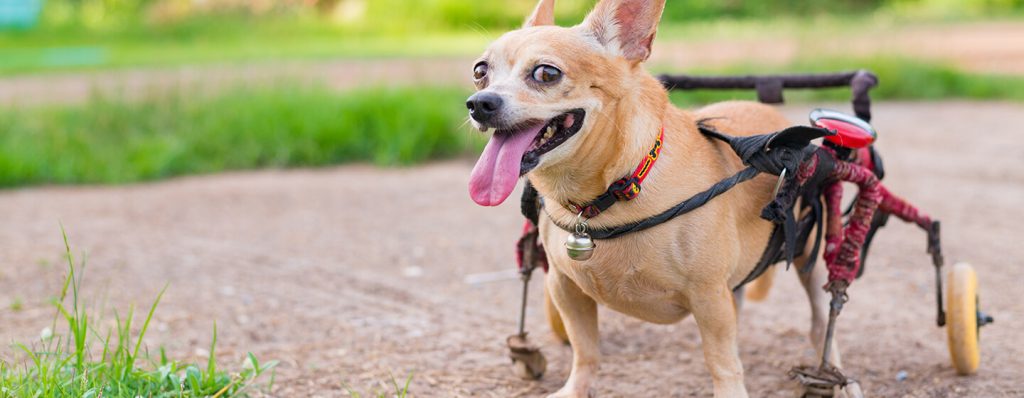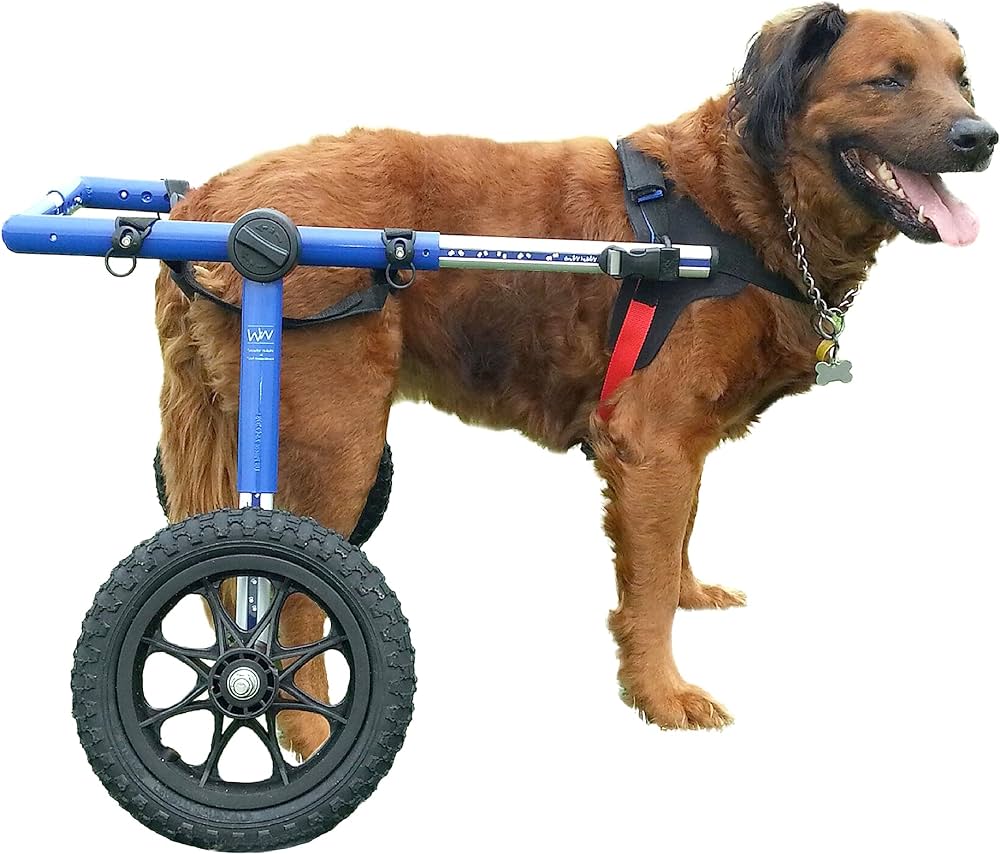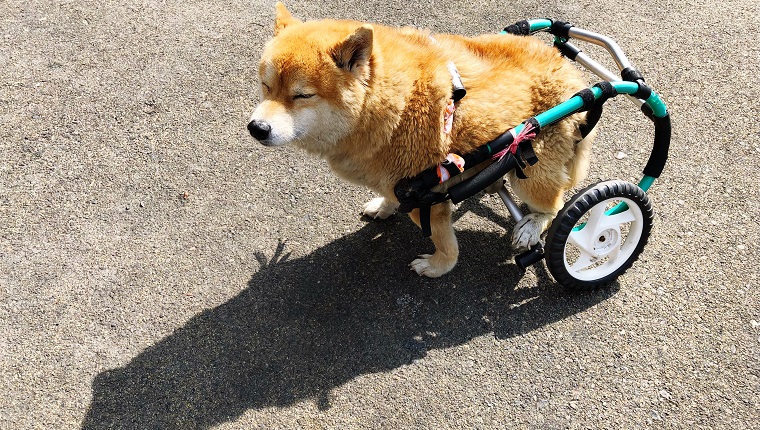Imagine a world where a dog’s mobility is not hindered by disability, where their wagging tails and playful spirit remain unhindered. In this article, we explore the question of whether a dog can truly live a happy life in a dog wheelchair. Discover how these innovative devices have transformed the lives of countless four-legged friends, providing them with newfound independence and the ability to continue enjoying all the joys that life has to offer.
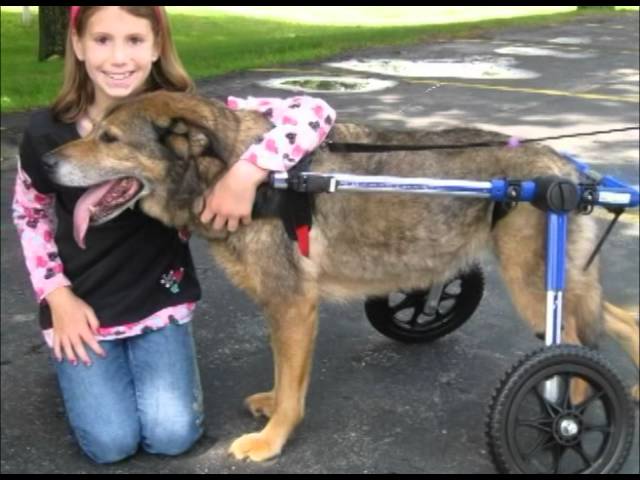
Benefits of a Dog Wheelchair
Improved Mobility
Having a dog wheelchair can greatly improve your furry friend’s mobility. It allows them to move around independently and explore their surroundings with ease. Whether your dog has a temporary injury or a permanent mobility issue, a wheelchair can offer them the freedom to enjoy their walks and playtime again. With the help of a wheelchair, your dog can regain their mobility and continue to live an active and fulfilling life.
Increased Independence
A dog wheelchair can also provide your canine companion with increased independence. Instead of relying on you or others to carry them or provide constant assistance, they can navigate their environment on their own. This newfound independence can boost their confidence and overall happiness. Your dog will no longer feel restricted or limited in their activities, as they can now venture out, run, and play just like before.
Pain Relief
Dogs with mobility issues often experience pain and discomfort. Whether it’s due to an injury, arthritis, or a degenerative condition, a wheelchair can help alleviate this pain. By properly supporting your dog’s back and legs, a wheelchair reduces the strain on their joints and bones. This can result in significant pain relief, allowing your furry friend to move around comfortably without exacerbating their existing condition. It’s vital to consult with your veterinarian to ensure the wheelchair is correctly fitted to provide maximum pain relief for your dog.
Improved Mental Health
Physical limitations can take a toll on a dog’s mental health. They may feel frustrated, anxious, or depressed due to the inability to participate in their favorite activities or interact with their surroundings. However, a dog wheelchair can positively impact their mental well-being. By enabling them to maintain an active lifestyle and continue with their daily routines, a wheelchair can prevent feelings of boredom and isolation. Your dog will remain mentally stimulated, engaged, and fulfilled, which is crucial for their overall happiness and quality of life.
Factors to Consider
Size and Weight of the Dog
When considering a dog wheelchair, it’s important to take into account the size and weight of your dog. Different wheelchair models are designed for specific weight ranges, so it’s vital to choose one that can adequately support your dog’s size and weight. Failing to do so may result in discomfort, improper fit, or even potential injuries. Take accurate measurements of your dog’s height, length, and weight to ensure a proper fit and maximum comfort.
Type and Severity of the Mobility Issue
The type and severity of your dog’s mobility issue will also influence the choice of a wheelchair. Different wheelchairs cater to different mobility issues, such as rear-leg weakness, paralysis, or front-leg support. Some dogs may require a wheelchair that allows them to have their paws touching the ground, while others may need a design that elevates the hindquarters. It’s crucial to consult with your veterinarian or a canine rehabilitation specialist to determine the most suitable wheelchair for your dog’s specific needs.
Age and Health of the Dog
Age and overall health play a crucial role in determining whether a dog wheelchair is the right solution. Younger, healthier dogs may quickly adapt to using a wheelchair and experience significant mobility improvements. However, older dogs or those with underlying health issues may require additional consideration. It’s essential to consult with your veterinarian and carefully assess your dog’s overall health before opting for a wheelchair. They can provide valuable guidance on whether a wheelchair is the best option or if alternative treatments or therapies should be considered.
Adapting to a Dog Wheelchair
Transition Period
It’s natural for your dog to experience a transition period when first introduced to a wheelchair. They may feel uncertain, hesitant, or even resistant to using it. Therefore, patience and gentle encouragement are essential during this phase. Start by gradually introducing the wheelchair to your dog, allowing them to sniff and inspect it without any pressure to use it immediately. Use positive reinforcement, such as treats and praise, to create a positive association with the wheelchair. Over time, increase their exposure to the wheelchair and gradually guide them in using it until they feel comfortable and confident.
Proper Fit and Adjustment
A proper fit is crucial for your dog’s comfort and safety while using a wheelchair. Each dog wheelchair should come with adjustable features to ensure the perfect fit. Take accurate measurements of your dog’s height, length, girth, and weight, and select a wheelchair that matches those measurements. Once you have the wheelchair, properly adjust the straps, harnesses, and supports to securely hold your dog in place without causing any discomfort or restriction. Regularly check the fit and make necessary adjustments as your dog grows or if any changes in their body occur.
Training and Conditioning
Training and conditioning are essential for your dog to adapt to their wheelchair and build strength and endurance. Gradually introduce your dog to short sessions of wheelchair use, focusing on gentle movements and encouraging them to walk or run in their wheelchair. Provide positive reinforcement and rewards to motivate and engage them during these training sessions. It’s important to remember that each dog’s adaptation process may vary, so be patient and adjust the training pace according to your dog’s comfort and progress. Consulting with a canine rehabilitation specialist can provide additional guidance and expertise in training and conditioning.
Maintaining Quality of Life
Regular Exercise and Physical Therapy
A dog wheelchair should not replace regular exercise and physical therapy. It’s important to continue engaging your dog in appropriate exercise routines and physical therapy sessions to maintain their overall health and well-being. Regular exercise helps in strengthening their muscles, improving circulation, and preventing weight gain. Physical therapy can also be beneficial in maintaining joint flexibility, relieving pain, and promoting overall mobility. Consult with your veterinarian or a canine rehabilitation specialist to develop a tailored exercise and physical therapy plan that complements your dog’s wheelchair use.
Appropriate Diet and Nutrition
Proper diet and nutrition are crucial for dogs with mobility issues, especially those using wheelchairs. Maintaining a healthy weight is essential to minimize additional strain on their joints and supporting structures. Consult with your veterinarian to ensure your dog is on a well-balanced diet that meets their specific nutritional needs. They can recommend a diet that promotes joint health, reduces inflammation, and supports overall vitality. Additionally, consider incorporating joint supplements or anti-inflammatory foods into their diet to provide additional support for their mobility.
Hygiene and Skin Care
Wheelchair use may require a bit of extra attention to your dog’s hygiene and skin care. Make sure to regularly inspect your dog’s skin for any irritation or pressure sores caused by the wheelchair. It’s essential to keep their coat clean and groomed to prevent matting or bacterial build-up. Regularly wash and disinfect the wheelchair to maintain cleanliness and prevent any odors or contaminants. Consulting with your veterinarian or groomer can provide specific guidance on proper hygiene and skin care practices for your dog in a wheelchair.
Mental Stimulation and Enrichment
In addition to physical well-being, mental stimulation and enrichment are essential for maintaining a high quality of life for your dog. Engage them in interactive games, puzzle toys, and training sessions to keep their minds sharp and active. Provide them with a variety of toys that encourage exploration and problem-solving. Regular walks in new environments, exposure to different smells, and socialization with other dogs can also provide mental stimulation and enrichment. A dog in a wheelchair should have the same opportunities for mental engagement as any other dog, so be sure to incorporate these activities into their daily routine.
Socialization with Other Dogs
Socialization is crucial for your dog’s emotional well-being. Interacting with other dogs provides mental stimulation, encourages appropriate behavior, and helps build their confidence. While a dog in a wheelchair may face some unique challenges, they can still enjoy socialization with other dogs. Look for dog-friendly parks or organized meet-ups where your dog can safely interact with other dogs. Supervised playdates with friendly and well-behaved dogs can also be beneficial. Socialization not only enriches your dog’s life but also provides an opportunity for other dog owners to see that a wheelchair doesn’t hinder a dog’s ability to interact and enjoy social activities.

Case Studies and Success Stories
Stories of Dogs Thriving in Wheelchairs
There are countless heartwarming stories of dogs who have thrived in wheelchairs. These inspiring tales showcase the resilience and adaptability of our canine companions. From small dogs to large breeds, dogs of all sizes and ages have proven that a wheelchair can enhance their quality of life. Stories of dogs with spinal injuries or degenerative conditions being able to run, play, and lead fulfilling lives are a testament to how transformative a wheelchair can be. It’s important to celebrate these success stories and draw inspiration from them as we make decisions about our own dogs’ mobility needs.
Positive Impact on Dog-Owner Bond
Using a dog wheelchair can also strengthen the bond between dog and owner. As you provide support and care for your dog during their adaptation to the wheelchair, a deep sense of trust and understanding develops. This bond only grows stronger as you witness the joy and freedom your dog experiences when using their wheelchair. Your dog will perceive you as their trusted partner, relying on you for guidance and assistance. The shared experiences and milestones during their wheelchair journey can create an unbreakable bond, enhancing the relationship between you and your beloved furry friend.
Inspirational Examples
In addition to individual success stories, there are many well-known examples of dogs who have thrived in wheelchairs. These dogs have become symbols of resilience, spreading inspiration and hope to others facing similar challenges. One such example is Naki’o, a mixed-breed dog who lost his paws due to frostbite. With the help of prosthetic limbs and a wheelchair, Naki’o not only regained his mobility but also received worldwide recognition for his perseverance and determination. These inspirational examples remind us that a wheelchair is not a limitation but a tool that allows dogs to overcome obstacles and live their lives to the fullest.
Common Concerns and Misconceptions
Restriction in Activity
One common concern is that a dog wheelchair may restrict a dog’s activity. However, with the proper fit and adjustment, a wheelchair should actually enhance a dog’s activity level. Instead of being confined to a small space or having limited mobility, a dog in a wheelchair can explore their environment more freely and engage in physical activities without discomfort or pain. Dog wheelchairs are designed to provide support and stability while allowing dogs to run, walk, and play just as they would without one.
Dependence on the Wheelchair
Another misconception is that dogs become overly dependent on their wheelchairs. While it’s true that a wheelchair greatly improves a dog’s mobility, it doesn’t mean they will lose their ability to move without it. Dogs are adaptive creatures, and using a wheelchair is simply a means to enhance their quality of life. They can still walk or move around without the wheelchair if necessary. However, the wheelchair provides them with the opportunity to engage in activities that may otherwise be difficult or painful, allowing them to maintain their independence and overall mobility.
Physical Discomfort or Pain
Some dog owners worry that a wheelchair may cause physical discomfort or pain for their furry friend. It’s important to note that a well-fitted and properly adjusted wheelchair should not cause any discomfort or pain. In fact, it should alleviate pain by providing support to their weakened or injured limbs. Regular check-ups with your veterinarian or a canine rehabilitation specialist can ensure that the wheelchair continues to fit correctly and is providing maximum comfort for your dog. Monitoring your dog closely for any signs of discomfort or irritation and making necessary adjustments will help maintain their well-being and prevent any potential issues.
Negative Impact on the Dog’s Spirit
While it’s understandable to worry about the emotional well-being of a dog using a wheelchair, it’s important to remember that dogs are incredibly resilient. With the right support and care, dogs can adapt to using a wheelchair and maintain their spirits. They may initially feel unsure or hesitant, but most dogs quickly adjust and regain confidence as they experience the benefits of improved mobility. A loving and supportive environment, along with ample opportunities for mental and physical stimulation, will help ensure that your dog’s spirit remains strong and unwavering.

Seeking Professional Guidance
Consulting with Veterinarians or Canine Rehab Specialists
When considering a dog wheelchair, it’s crucial to consult with professionals who specialize in veterinary medicine or canine rehabilitation. Veterinarians can assess your dog’s overall health, address any underlying issues, and provide valuable advice on the suitability of a wheelchair for your dog’s specific condition. Canine rehabilitation specialists can offer expertise in customizing a wheelchair to fit your dog perfectly and provide guidance on training, conditioning, and managing any additional therapies or treatments. Their knowledge and experience will ensure the best possible outcome for your dog’s mobility needs.
Getting Recommendations and Guidance from Other Dog Wheelchair Users
In addition to professional guidance, connecting with other dog wheelchair users can also provide valuable insights and support. Online communities and forums dedicated to dog wheelchairs allow dog owners to share their experiences, exchange tips, and ask questions. Hearing firsthand accounts from other dog owners who have gone through similar experiences can offer reassurance and practical advice. They can provide recommendations for the best wheelchair models, offer insights on managing everyday challenges, and provide emotional support during the transition period. Learning from the experiences of others can help you make informed decisions and navigate the journey of integrating a wheelchair into your dog’s life.
Alternative Mobility Solutions
Physical Therapy and Rehabilitation
Although a dog wheelchair is an effective solution for mobility issues, it’s important to explore other options as well. Physical therapy and rehabilitation can complement the use of a wheelchair and provide additional benefits. A canine rehabilitation specialist can develop a customized treatment plan that includes exercises, stretches, and therapeutic modalities to improve your dog’s strength, flexibility, and overall mobility. Physical therapy can help address underlying musculoskeletal issues, improve the range of motion in affected limbs, and optimize your dog’s overall mobility.
Assistive Devices and Accessories
In some cases, assistive devices and accessories can be used in combination with a dog wheelchair to further enhance mobility. These devices can provide additional support, stability, or protection to certain areas of the body. For example, a front-leg harness can help dogs with front-leg weakness maintain their balance and stability while using a wheelchair. Boots, socks, or foot covers can prevent paw injuries and improve traction. Speak to your veterinarian or a canine rehabilitation specialist to discuss any potential options that may benefit your dog’s specific mobility needs.
Alternative Treatments and Therapies
While a wheelchair and physical therapy are common approaches, alternative treatments and therapies may also be worth considering. These can include acupuncture, hydrotherapy, laser therapy, chiropractic care, or the use of orthotics and prosthetics. Each dog’s situation is unique, and a combination of treatments may provide the greatest benefit. It’s crucial to consult with your veterinarian or a specialist who is well-versed in alternative treatments to determine if they are appropriate for your dog’s specific condition and to ensure coordinated and comprehensive care.
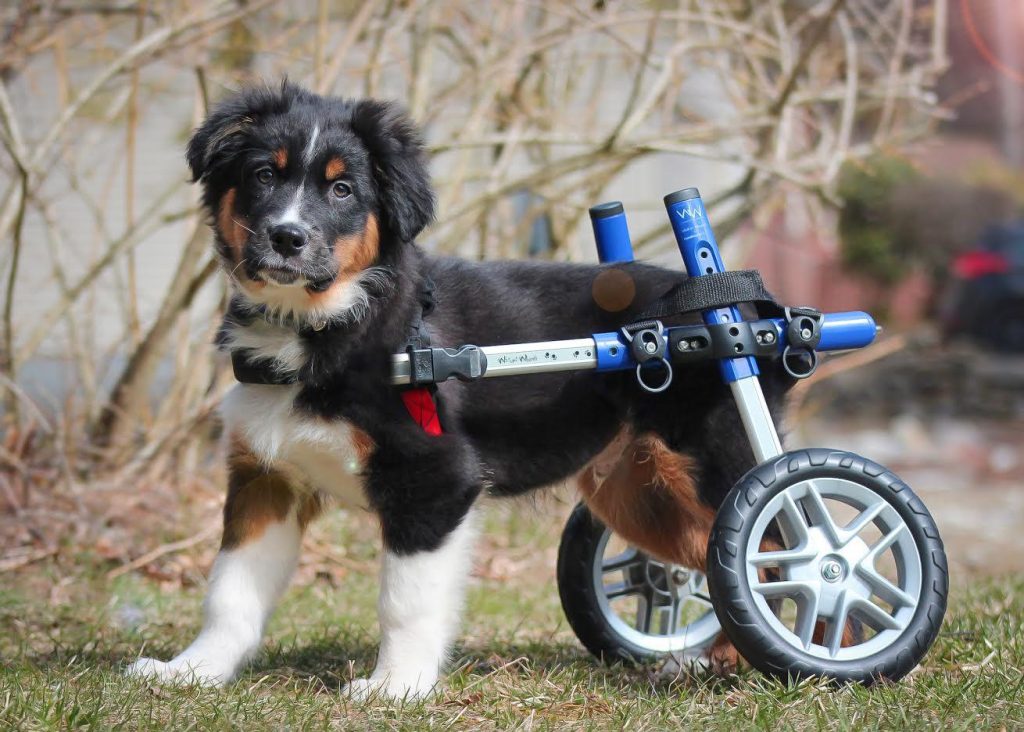
Support for Dog Wheelchair Users
Online Communities and Forums
One of the most valuable sources of support for dog wheelchair users is online communities and forums. These platforms bring together dog owners who understand the unique challenges and triumphs of life with a wheelchair-bound pup. Joining these communities allows you to share your experiences, ask questions, seek advice, and receive emotional support from others who have walked a similar path. From tips on wheelchair maintenance to recommendations for accessible products, these communities can provide a wealth of information and camaraderie.
Accessible Products and Resources
As the demand for dog wheelchairs continues to grow, so does the availability of accessible products and resources. There are numerous companies specializing in designing and manufacturing dog wheelchairs to cater to different breeds, sizes, and mobility issues. Additionally, there are online resources dedicated to providing information, guides, and videos on wheelchair selection, fitting, and maintenance. These resources can help you make informed decisions about your dog’s mobility needs and ensure you have the necessary tools and knowledge to support them.
Financial Assistance Programs
Purchasing a dog wheelchair, along with ongoing care, can be a significant financial burden for some dog owners. However, there are financial assistance programs available to help alleviate these costs. Many nonprofit organizations provide grants or funding opportunities specifically for owners of disabled pets. These programs can help cover the expenses of a wheelchair, veterinary care, physical therapy, or other related needs. Research local and national organizations that offer financial assistance for dog wheelchair users to determine if you qualify for any support.
Conclusion
In conclusion, a dog wheelchair can greatly enhance a dog’s quality of life, ensuring they can continue to live a happy and fulfilling life despite mobility issues. The improved mobility, increased independence, pain relief, and positive impact on mental health are just a few of the many benefits a dog wheelchair offers. However, several factors need to be considered when choosing a wheelchair, such as the size and weight of the dog, the type and severity of the mobility issue, and the age and health of the dog.
Adapting to a dog wheelchair requires patience, proper fit, adjustment, training, and conditioning. It’s important to maintain the overall well-being of your dog by incorporating regular exercise, a proper diet, hygiene, mental stimulation, and socialization with other dogs. Additionally, there are many case studies and success stories that demonstrate the transformative power of a dog wheelchair and the positive impact it has on the dog-owner bond.
While some concerns and misconceptions may arise, it’s crucial to seek professional guidance, such as veterinarians and canine rehabilitation specialists, who can provide expert advice and support. Exploring alternative mobility solutions, such as physical therapy, assistive devices, and alternative treatments, can also complement the use of a dog wheelchair. Lastly, there are online communities, accessible products and resources, and financial assistance programs available to offer support and resources for dog wheelchair users.
Ultimately, the ability for a dog to live a happy life in a wheelchair lies in the individual consideration, adaptation, and dedication of their owner. With the right care, support, and love, a dog can overcome physical limitations and continue to thrive, embracing a life of joy, adventure, and companionship.
